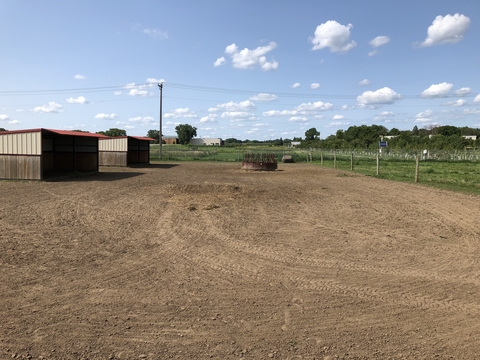Quick facts
- Dry lots are fenced areas that are bare of grass and key to rotational grazing systems.
- Dry lots should provide shelter, water, feed and at least 400 square feet per horse.
- High-traffic pads can help control mud prone areas in a dry lot.
- Always enclose dry lots with permanent fencing and place gates to allow access to nearby pastures.
- Remove manure from dry lots regularly.
Benefits of dry lots
Dry lots play a key role in rotational grazing systems. They are an area for providing shelter, hay, feed, water and access to adjacent paddocks and pastures.
- Dry lots are an area to house horses when pastures need rest such as when most of the pasture has been grazed to 3 to 4 inches or during the winter when pasture is no longer growing.
- Dry lots also provide space and turnout for horses with metabolic syndrome that cannot safely graze pasture due to the potentially high nonstructural carbohydrate content of grass.
Horses only turned out to dry lot will need hay to make sure they reach their dietary needs. On a dry matter basis, most horses commonly consume around 2 percent of their body weight in forage per day.
Where should you place your dry lot?
Here are a few standard guidelines for dry lot layout:
- Plan ahead for how you want to use your dry lot. If you want to rotationally graze, ensure that all pastures are adjacent to the dry lot and can be accessed through gates and/or laneways.
- Install systems for managing precipitation such as gutters, swales and rain barrels. Managing water flow will help you manage mud.
- Install high-traffic pads to help promote drainage in areas prone to mud build-up such as near gates, along laneways, and around shelters, feeders and drinking water sources.
- Plan for at least 400 square feet per average sized, 1,100-pound horse. This space does not include space required for shelters, feeders or water sources and assumes multiple horses housed together get along.
- Make sure that horses can easily move within the dry lot and have access to shelters, feeders and water sources. If horses do not get along, you may need to provide more space. If horses are larger than average, scale up in size.
- Shelters should be three-sided, placed to block winds, and allow for all horses to have access in poor weather conditions. Recommendations for size vary, but a general guideline is 72 to 144 square feet per averaged sized horse, assuming all horses in the herd get along. If horses do not get along or are larger in size, you may need to provide more space.
- Make sure your dry lot is not too big. This will help you easily maintain a weed-free space for your horses.
Selecting fencing and placing gates
- Always use a permanent, sturdy fencing to enclose a dry lot. Fencing options include:
- Three- or four-board, wood fence
- No-climb wire mesh fencing
- Corral panels
- Permanent electric fencing
- Or a combination of these fence types
- Fencing should be easy to see. If you use electric fencing make sure it is constantly electrified.
- When possible use rounded corners to help avoid areas horses can become trapped.
- Place gates in corners and make sure they are large enough to allow access by large farm equipment. We recommend 16-foot gates for these passages.
- Consider including a 4-foot gate for easy access to the dry lot for people or a single horse. This can be useful when trying to enter the dry lot with a wheel barrow or other management supplies.
- Hang gates depending on how you would like them to swing and pick appropriate hardware for latching.
- Gates hung in line with the fence can swing both directions but will create a space behind the gate. This space can be a hazard if a horse were to get caught behind it if left open for paddock access from the dry lot.
- Gates hung parallel to the fence line on the outside of the post, sometimes called a “slam gate”, will only swing one direction but will reach the fence line when swung out. When installing a slam gate, make sure that the gate opens into the enclosure and when shut, rests against the latching post. This ensures that the gate will stay closed if a horse were to lean against it and break the latch.
Maintaining your dry lot
- Remove manure regularly, ideally daily. Remember to follow local and state laws on proper manure handling and storage.
- Control weeds through regular mowing, clipping or herbicide applications. However, a correctly sized dry lot should not become weedy.
- Dragging may be necessary to maintain a level surface.
Reviewed in 2024


